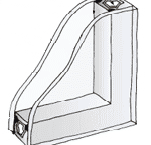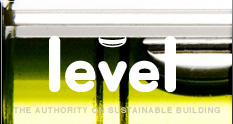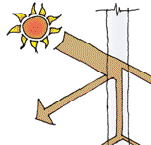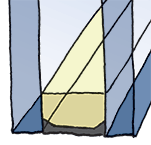- Home
- Site Analysis
- Site Use
- Passive Design
- Water
- Material Use
- Energy
- Wet Areas
- Health and Safety
- Other Resources
Passive Design
Designing the building and the spaces within it to benefit from natural light, ventilation and even temperatures.
Glazing options for temperature control
Thermal performance of windows and glazed doors is determined by the type of glass used, the framing material, and the unit’s construction.
On this page:
- Insulating glass units (IGUs)
- Secondary glazing
- Solar control glazing
- Framing materials
- Specifying solar heat gain coefficient (SHGC)
All of these factors together determine the thermal – as well as optical – performance of a glazing unit. All, therefore, must be considered together, along with other elements of passive design such as window size, placement and orientation, and insulation in other parts of the building envelope.
Insulating glass units (IGUs)
Insulating glass units (IGUs) may be double- or triple-glazed, although double-glazed units are more common.
A double-glazed IGU typically consists of two sheets of glass spaced apart, typically with a hollow aluminium frame that is sealed to both panes. The space between the panes may contain dry air or be filled with argon gas.

- Typical insulating glass unit construction
Insulating glass units (IGUs) can have a significant effect on heat loss or gain, condensation, the transfer of noise, and other visual and aesthetic properties.
IGUs can limit heat transfer by:
- conduction – due to the high thermal resistance of the air or gas in the space between glazing panes
- convection – due to the inability of the still air between the panes to move and transfer heat
- radiation – due to two or more panes interrupting the radiation of energy and the low emissivity when using a low-emissivity (low-E) surface.
A wider gap between the two glass panes (12 or 16 mm rather than 8 mm) will usually give an increase in R-value for an air fill, and the improvement can be significant with high-performance low-E glazing. Gas fills work better with smaller gaps between panes.
Argon gas
Heat transfer through windows can be reduced by using argon gas between the panes of double or triple glazing.
Argon gas is a low-cost, clear, non-toxic, naturally occurring gas with a lower thermal conductance than air. Use of argon between glazing panes instead of air can reduce the amount of heat conducted across the gap and improve the R-value of the glazing by 5–20%.
Argon also substantially improves the R-value of IGUs where the gap between the panes is narrower than the recommended 10 mm minimum. Therefore, if the gap between panes must be reduced to 6–8 mm, such as when retrofitting IGUs into existing timber frame windows, argon gas-filled units should be used.
Krypton gas
The options for gas fill in IGUs in the Building Code Acceptable Solution H1/AS1 (5th edition) include krypton. Krypton gas is an even better insulator than argon but is more expensive. IGUs with krypton filling have not been commercially produced in New Zealand although that may change. Overseas, krypton is often used in reglazing heritage windows where a narrow gap is required between panes.
Other benefits of insulating glass units
In addition to improving the thermal performance of windows, IGUs also provide other benefits such as reducing condensation (where there is a thermal break in the frame in aluminium frames), reducing noise transmission, and reducing the need for drapes or curtains (although these should still be installed for use on cold nights).
Triple glazing
Triple glazing can be significantly more expensive than double glazing and is heavier, but it is being specified more commonly today in areas with very cold winters. With three panes of glass, there are two controlled spaces that can both be filled with argon gas. Low-E coatings can also be used. As with double glazing, construction of the window has an impact on its performance. Timber and uPVC frames give better performance, as do frames with thermally efficient (“warm edge”) spacers separating the panes of glass, rather than aluminium spacers.
Secondary glazing
A less expensive option for improving the thermal performance of existing single-glazed windows is to install secondary glazing. With this, plastic film, magnetically attached plastic sheet, plain or low-E glass is installed inside the existing glass with a still air gap between them.
Research (supported by BRANZ) found that secondary glazing gave R-values from 0.36 to 0.57 m2 K/W. This means that secondary glazing can be used as a functional alternative to retrofitted insulating glass units in existing domestic single-glazed window frames. (In fact, the performance exceeded the expected performance of IGUs retrofitted into the existing framing due to the secondary glazing effectively insulating the framing.)
Solar control glazing
Solar control glazing is any glazing that is tinted, has a reflective or a low-E coated surface, or has spectrally selective characteristics. Many of these properties are frequently combined in one product to provide greater solar control.
Reflective glazing
Reflective glazing, has coatings typically added to the surface of glazing panes that have a higher reflectivity than standard glass. The reflectivity can be tuned to selectively:
- reflect short-wave solar radiation, or
- reflect long-wave heat radiation.
The reflective ability depends on the particular coating and on the orientation of the glazing. High-reflectivity coatings generally have low light transmission properties, but reflective glazing systems with lower reflectivity and higher light transmission properties are also available for domestic use.
Reflective coatings may be added to tinted glazing to further enhance the solar control performance of the glazing.
The reflection is typically towards the side with brighter illumination, so at night, the direction of the reflectivity can change so that the reflection is to the interior.
Low-E glazing
Low-E coatings are applied to the surface of glazing panes with specific solar control properties. A microscopically thin metallic coating is added to the glazing surface, which lets light through but reflects short-wave infrared radiation. This suppresses the radiant heat flow. Converting one pane of a clear double-glazed IGU to low-E glazing is approximately equivalent to adding a third clear pane.
Low-E coated glazing is generally clear, and different types of coatings are available for high, moderate or low solar gain.
Low-E glazing is typically only used with insulated glazing units, which provide protection to the coating from the possibility of damage. The low-E coating is either:
- on the cavity-face of the inside pane (surface 3 in the drawing below) to retain heat in colder climates
- on the cavity face of the outside pane (surface 2 in the drawing below) to keep heat out in warmer climates.
Spectrally selective glazing
Spectrally selective glazing maximises the amount of visible light that gets into a building, but minimises the amount of solar heat that passes through. Spectrally selective glazing, under one definition, allows 25% more light (measured as visible transmittance, Tvis) to pass through than heat (measured as the solar heat gain coefficient – SHGC). This gives a light to solar gain ratio of at least 1.25.
A glazing system that passes 80% of the visible light (a Tvis of 0.8) and 64% of the solar heat (a SHGC of 0.64) therefore has a light to solar gain ratio (LSG) of 1.25. This just meets the threshold of being a spectrally selective glazing system. A higher Tvis and a lower SHGC gives better LSG, and better performance in climates with high solar intensity.
The spectrally selective coating is typically found on an inside face of the IGU for protection.
Framing materials
The thermal performance of any window frame will depend on its construction, but in general timber, composite timber/aluminium, uPVC and fibreglass frames provide better thermal insulation than ordinary aluminium frames.
Fibreglass window frames are relatively new in New Zealand. Fibreglass has a vastly better thermal efficiency than aluminium. It has the same coefficient of expansion as glass, so it does not expand and contract as much as uVPC and aluminium frames. This means less stress for junctions and joints.
Thermally broken aluminium frames have a very strong spacer with a higher level of thermal performance between the inner and outer parts of the aluminium frame.
BRANZ research has shown that if thermally-broken fram/-e coating are specified instead of the typical low-quality double glazing, the benefits are substantial.
Be aware that the colour of a window frame can have an impact on solar heat gain. For example, a black frame on the north side of a house could easily reach a temperature exceeding 50°C in mid-summer and this heat may be radiated inside. Lighter-coloured, thermally-broken frames can help to reduce overheating inside a home.
Specifying solar heat gain coefficient (SHGC)
When specifying glazing units:
- Where passive solar gain is desirable, east-, north- and perhaps west-facing windows should have windows with high SHGC.
- Where late afternoon passive solar gain is undesirable, west-facing windows should have a low SHGC (less than 0.4).
- Where passive solar cooling is required, low SHGC windows should be used for north- and west-facing windows.
- For south-facing windows, the SHGC has less effect, but where passive solar gain is desirable, glazing should have a high R-value and a high SHGC.
The SHGC does not necessarily have a direct correlation to visible light transmittance. For example, some advanced tinted float glazing will allow a high transmission of visible light but also have a low SHGC.
See measuring glazing performance: key concepts for an explanation of SHGC.
Updated: 09 March 2023



